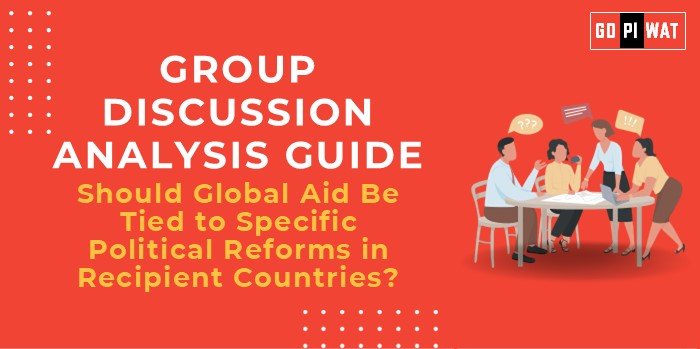📋 Group Discussion (GD) Analysis Guide: Should Global Aid Be Tied to Specific Political Reforms in Recipient Countries?
🌐 Introduction to the Topic
- 📌 Opening Context: International aid serves as a critical tool for humanitarian assistance and development. The debate over whether aid should be conditioned on political reforms is central to discussions about sovereignty, accountability, and global ethics.
- 📖 Topic Background: The idea of tying aid to political reforms gained traction post-Cold War, with donor nations often using aid to promote democracy and human rights. While this approach can drive change, it raises questions about its effectiveness and ethical implications.
📊 Quick Facts and Key Statistics
🌍 Global Aid Distribution: $204 billion in official development assistance (ODA) in 2022 (OECD).
📈 Conditionality Prevalence: 50% of bilateral aid includes governance or reform-related conditions (World Bank).
📊 Democracy Index Correlation: Aid-tied reforms have reportedly improved governance scores in 12% of recipient nations (UNDP).
📉 Aid Failure Rate: 30-50% of aid projects fail due to non-compliance or weak governance (USAID).
📈 Conditionality Prevalence: 50% of bilateral aid includes governance or reform-related conditions (World Bank).
📊 Democracy Index Correlation: Aid-tied reforms have reportedly improved governance scores in 12% of recipient nations (UNDP).
📉 Aid Failure Rate: 30-50% of aid projects fail due to non-compliance or weak governance (USAID).
👥 Stakeholders and Their Roles
- 🏛️ Donor Nations: Influence governance, advocate reforms, and drive strategic interests.
- 🌍 Recipient Governments: Face challenges balancing aid conditions with domestic priorities.
- 🌱 NGOs: Facilitate reforms and act as intermediaries.
- 📜 International Organizations: Set frameworks for governance-linked aid (e.g., UN, IMF).
🏆 Achievements and Challenges
✨ Achievements:
- 📈 Governance Improvements: Aid conditions improved transparency in countries like Rwanda.
- 🤝 Human Rights Advocacy: Aid tied to reforms reduced human rights abuses in Colombia.
- 💵 Economic Stability: Conditional aid helped stabilize economies in post-conflict nations like Bosnia.
⚠️ Challenges:
- ⚖️ Sovereignty Issues: Critics argue it undermines recipient autonomy, as seen in Zimbabwe.
- 🚧 Implementation Gaps: Countries like Afghanistan struggled to meet donor expectations despite aid.
- 🌍 Global Comparisons: Scandinavian aid programs succeeded with fewer conditions, while strict U.S. approaches faced resistance.
Case Studies: Ethiopia’s governance reforms saw partial success but highlighted accountability concerns.
📢 Structured Arguments for Discussion
- ✅ Supporting Stance: “Aid conditionality ensures accountability and promotes long-term governance stability.”
- ❌ Opposing Stance: “Tying aid to reforms undermines sovereignty and risks alienating recipient governments.”
- ⚖️ Balanced Perspective: “While conditionality promotes reform, its design must respect local contexts and priorities.”
🧠 Effective Discussion Approaches
- 🎯 Opening Approaches:
- Use statistics: “50% of bilateral aid includes governance-related conditions, sparking debates about its ethical implications.”
- Present a scenario: “What happens when conditions conflict with urgent humanitarian needs?”
- 🤝 Counter-Argument Handling:
- Example: “While sovereignty is important, Rwanda’s success shows conditionality can drive reforms when aligned with local goals.”
📊 Strategic Analysis of Strengths and Weaknesses
- 🌟 Strengths: Promotes accountability, improves governance, aligns aid with strategic goals.
- ⚠️ Weaknesses: Risks of non-compliance, potential cultural insensitivity.
- 📈 Opportunities: Leveraging partnerships, fostering long-term development.
- ⚡ Threats: Resistance, politicization of aid, global backlash.
🎓 Connecting with B-School Applications
- 💼 Real-World Applications:
- Public policy analysis, ethics in international relations, and global supply chain impacts.
- 📚 Sample Interview Questions:
- “How should aid programs balance sovereignty with accountability?”
- “Discuss a successful case of aid driving political reform.”
- 💡 Insights for B-School Students:
- Understand global power dynamics.
- Develop negotiation skills for international projects.
- Explore public-private partnerships in policy reform.


